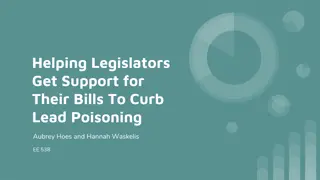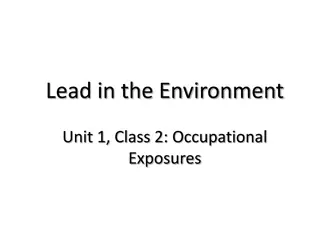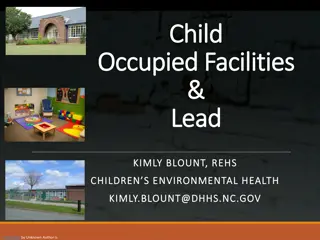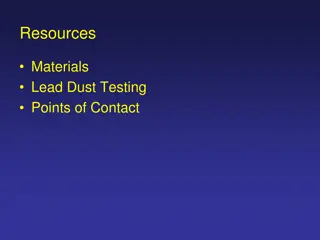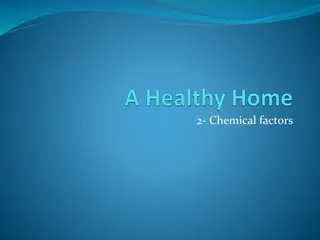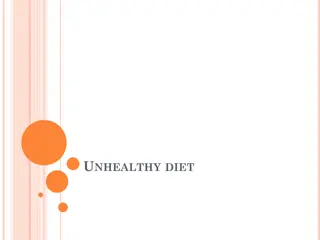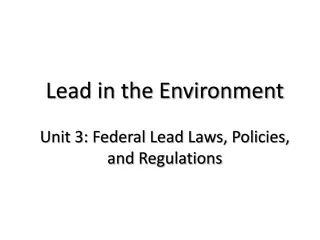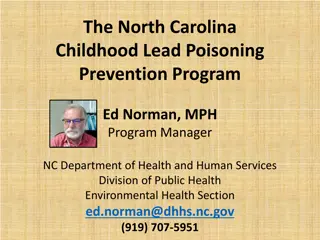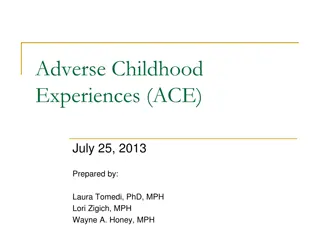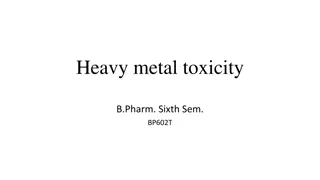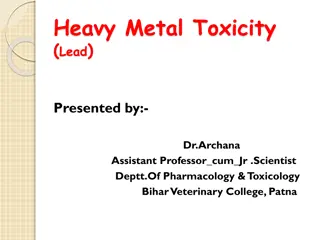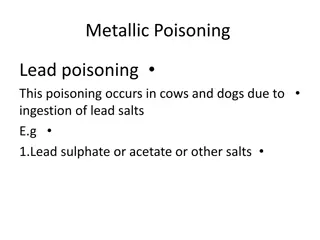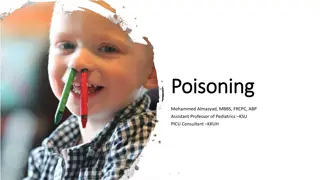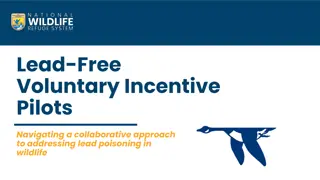Childhood Lead Poisoning Prevention Program Overview
This content highlights the importance of preventing childhood lead poisoning, discussing its risks, health effects, sources, and testing methods. It emphasizes the need for early detection and provides essential information for parents and caregivers on reducing lead exposure in young children.
Uploaded on Sep 10, 2024 | 9 Views
Download Presentation

Please find below an Image/Link to download the presentation.
The content on the website is provided AS IS for your information and personal use only. It may not be sold, licensed, or shared on other websites without obtaining consent from the author.If you encounter any issues during the download, it is possible that the publisher has removed the file from their server.
You are allowed to download the files provided on this website for personal or commercial use, subject to the condition that they are used lawfully. All files are the property of their respective owners.
The content on the website is provided AS IS for your information and personal use only. It may not be sold, licensed, or shared on other websites without obtaining consent from the author.
E N D
Presentation Transcript
CHILDHOOD LEAD POISONING PREVENTION Developed with funding from the California Department of Education
Goals: 1. Define the problem of lead poisoning. 2. Identify steps to reduce lead exposure for young children. 3. Learn how to inspect for lead. 4. Be able to share information with families and encourage parents to test children for lead. 2
Why is lead poisoning an issue? Lead poisoning is one of the most common and preventable environmental illnesses. Around 1 in 100 children under age 6 years old in California are found to have elevated blood lead levels. (CDPH 2015)* Young children are more vulnerable to lead s toxic effects. 3
Why are young children at risk? Children explore the environment using their hands and mouths. They spend a lot of time on the floor and ground where sources of lead may be found. Children absorb more ingested lead than adults. 4
What are the health effects of lead? Lead can affect a child s learning, behavior, and physical development. Anemia and lead poisoning may occur together. 5
How would I know if a child is lead poisoned? Most children with lead poisoning don t look or act sick. Testing is the ONLY way to know. Health care providers should assess children for risk of lead exposure at every well-child visit up to age 6. Children with risk factors should have a blood lead level (BLL) test. Children in publicly funded programs for low-income children (e.g. Head Start, Medi-Cal, Child Health and Disability Program (CHDP), and WIC) are required to have a BLL test at 12 and 24 months of age. 6
What are possible sources of lead? Lead-based paint in homes built before 1978. Paint that peels, cracks, chips, or creates dust* in homes built before 1978. Vinyl mini-blinds Bare dirt, old artificial turf, rubber mulch, artificial surfaces 8
Sources of lead, continued Water from wells or running through plumbing that contains lead Toys, particularly those that are old, painted, plastic, vinyl, or imported Some imported foods, including candy, spices, and seasonings. Some home remedies, make-up, and jewelry Some handmade or imported pottery, dishes, and water crocks 9
Sources of Lead, continued Lead brought in on clothes and shoes by parents who may be exposed at work Some hobbies such as making stained glass (lead solder), hunting or firing ranges (lead bullets), fishing (lead sinkers) Property near busy highways and some industries 10
What can child care providers do? Teach parents about lead poisoning Encourage parents to have their children screened for lead Promote good nutrition Reduce lead exposure in your facility Remove or wipe off shoes worn indoors 11
Reducing Environmental Exposure Wash toys regularly, especially toys and pacifiers that are frequently mouthed. Check toys, furniture, and equipment for chipping paint. Do not use supplies, equipment, old toys, or imported toys unless you know they are lead- free. Check CPSC for toy recalls: www.cpsc.gov/Recalls/ 13
Reducing Environmental Exposure Clean, sanitize, and disinfect 14
Reducing Environmental Exposure Inspect and address sources of lead monthly* *See curriculum booklet for a lead exposure checklist 15
Reducing Environmental Exposure Wash hands: Before eating and handling food After using the restroom, diapering or handling body fluids After playing outside Before going to bed (especially for children who suck their fingers/thumbs) Hands can carry germs and lead dust to mouths. 16
Lead in Tap Water Most tap water in California does not contain lead, BUTthe only way to know is to have it tested Licensed child care programs in buildings built before 2010 are required to have their tap water tested for lead between January 1, 2020 and January 1, 2023 and every five years thereafter and must inform parents of testing results. Contact your local public health department or licensing analyst for information about water testing. 18
Lead in Tap Water To reduce potential exposure to lead in tap water: Flush the pipes by running water until it feels coldest (usually at least 30 seconds and up to a few minutes, longer if taps have been off for 6 or more hours) Use only cold tap water for cooking, drinking and mixing baby formula (if used as an alternative to breastfeeding). If using a water filter, be sure to use an NSF- certified filter that removes lead. Change water filter according to manufacturer s instructions. 19
Lead and Nutrition Anemia and lead poisoning may occur together. Be sure to serve a variety of healthy foods for meals and snacks, especially those rich in iron, calcium, and Vitamin C. 20
Lead and Nutrition Iron rich foods are important so children don t become anemic. Sources of iron include meat, poultry, seafood, legumes, dark green vegetables, and foods enriched with iron such as fortified breads and cereals. Vitamin C helps the body absorb iron. Vitamin C is found in many fruits and vegetables. 9/10/2024
Painting, Repairing or Remodeling Contamination Risks for Your Child Care Environment *Please note: The EPA requires child care facilities built before 1978 to use certified lead-safe professionals for remodels and repairs. www.epa.gov/lead/renov ation-repair-and-painting- program-operators- childcare-facilities Was it built before 1978? Is it exposed to heavy automobile traffic? Is it near an industrial area where lead products have been used or produced. Does it have old artificial play surfaces?
Lead Testing Call your local public health department Childhood Lead Poisoning Prevention Program for testing information. Have your facility evaluated by a certified lead inspector. A list of certified assessor/inspectors is available on the CDPH website. https://www.cdph.ca.gov/Programs/CCDPHP/DEOD C/CLPPB/Pages/LRCcertlist.aspx Test any potential sources of lead, such as paint, soil, water, artificial turf and surfaces, rubber mulch, equipment, toys, and dishes. 23
Resources: Local Childhood Lead Poisoning Prevention Program (XXX) XXX-XXXX California Department of Public Health (CDPH) Childhood Lead Poisoning Branch (510) 620-5600 www.cdph.ca.gov/Programs/CLPPB California Child Care Health Program https://cchp.ucsf.edu Child Care Resource & Referral Consumer Education Line (800)-543-7793. Community Care Licensing Website https://www.cdss.ca.gov/inforesources/child-care-licensing 24
Resources: Centers for Disease Control (CDC): 5 Things for Lead Prevention https://www.cdc.gov/nceh/lead/tools/5things.pdf CDC: Lead in Toys https://www.cdc.gov/features/leadintoys/index.html Environmental Protection Agency (EPA) Brochure: Protect Your Family from Lead in your Home https://www.epa.gov/sites/production/files/2017- 06/documents/pyf_color_landscape_format_2017_508.pdf EPA Toolkit: Reducing Lead in Drinking Water https://www.epa.gov/ground-water-and-drinking-water/3ts- reducing-lead-drinking-water-toolkit 25
Resources: Food and Drug Administration (FDA): Lead and Food in Dishware https://www.fda.gov/food/metals/lead-food- foodwares-and-dietary-supplements California Department of Public Health (CDPH) Childhood Lead Poisoning Prevention Branch https://www.cdph.ca.gov/Programs/CCDPHP/DEODC/CLPPB/ Pages/prov_services.aspx CDPH maintains a list of lead-safe certified professionals in California. https://www.cdph.ca.gov/Programs/CCDPHP/DEODC/CLPPB/ Pages/LRCcertlist.aspx 26


